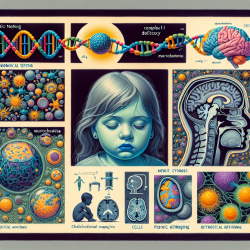Introduction
Leigh syndrome (LS) is a rare, progressive neurodegenerative disorder primarily affecting infants and children. This condition is characterized by bilateral symmetrical lesions in the basal ganglia and brainstem, leading to severe neurological impairment. The recent case report titled "Lip cyanosis as the first symptom of Leigh syndrome associated with mitochondrial complex I deficiency due to a compound heterozygous NDUFS1 mutation" sheds light on the early symptoms and diagnostic challenges of LS, emphasizing the role of genetic testing and neuroimaging in clinical practice.
Case Overview
The case report details a 24-day-old male infant who presented with lip cyanosis, an early symptom of LS. Despite normal initial brain MRI findings, the patient's condition rapidly progressed, leading to respiratory and circulatory failure. Genetic testing revealed compound heterozygous mutations in the NDUFS1 gene, confirming a diagnosis of mitochondrial respiratory chain complex I deficiency-related LS. This case underscores the importance of recognizing early symptoms like lip cyanosis and utilizing genetic testing for accurate diagnosis.
Clinical Implications
The findings from this case report have several implications for practitioners:
- Early Symptom Recognition: Practitioners should be vigilant for early signs of LS, such as lip cyanosis, which may indicate underlying respiratory muscle weakness and impending respiratory failure.
- Importance of Genetic Testing: Genetic testing, including whole-exome sequencing, is crucial for diagnosing LS, especially in cases with rapid progression and atypical presentations.
- Neuroimaging Considerations: Initial MRIs may appear normal in early LS stages. Repeat imaging is essential as the disease progresses to identify characteristic lesions in the basal ganglia and brainstem.
Encouraging Further Research
This case report highlights the need for further research into the clinical spectrum of LS and the development of more effective diagnostic and therapeutic strategies. Practitioners are encouraged to contribute to the growing body of research by documenting similar cases and exploring innovative treatment options.
Conclusion
Lip cyanosis can be a critical early indicator of LS, necessitating prompt genetic testing and neuroimaging for accurate diagnosis. By understanding the clinical implications of this case, practitioners can improve their diagnostic skills and contribute to better outcomes for children with LS.
To read the original research paper, please follow this link: Lip cyanosis as the first symptom of Leigh syndrome associated with mitochondrial complex I deficiency due to a compound heterozygous NDUFS1 mutation: A case report.










